Your Ultimate Guide to Personal Lubricants

Personal lubricants go hand-in-hand with condoms, and really, with sexual intercourse of all kinds. If you've ever explored this favorite adult bedroom activity, you know that moist is better than dry when it comes to aroused private parts. Wanting a nice glide applies to both genders equally.
In this article, we restrain from complicated, hard to pronounce product ingredients. We also don’t discuss any scientific studies, and instead, give you a simple-to-understand outlook on personal lubricants as a whole. You know, real-world info that actually applies to you.
There are a plethora of personal lubricants available on the market. Since you use lubes on your body's sensitive areas, you want to make sure to use the most trusted and gentle body products available.
Are you new to personal lubricants and don't know where to start? Have you been using lubes for some time but want to learn more? In either case, this ultimate guide to personal lubricants is just for you.
Here at CondomJungle, we are all about condoms. We know that lubes are a necessity to better your sexual enjoyment with prophylactics. Those two are like Bonnie and Clyde-- partners in crime and definitely better when working together.
Are you ready to slide?
Keep on reading because this article is all about slipping and sliding, up and down, down and up, from start to finish.
Are you getting at least a bit excited now?
What are personal lubricants?
Personal lubricants are specially designed substances used during sexual intercourse and masturbation. Their role is to moisturize to reduce friction during both skin-to-skin as well as skin-to-condom contact between the penis and vagina or anus. Whatever you might be into, lubes enhance your intimate sexual activity and supplement your body's natural lubrication.
Lubes come in several compositions, from light to thick and everything in between. You might already have your favorite brand or a type that serves your purpose just the way you like it. If not, stick around to find your next lube.
Some surgical or medical examinations also use specially designed lubricants, which are usually in a thicker gel form. We address these a bit later. Let's talk about quality first.
ALSO READ: Next Time, Take Astroglide for a Spin
Which lubes are safest for my body?
The Food and Drug Administration (FDA) classifies personal lubricants, as well as condoms, as medical devices. This federal agency oversees the quality of products to protect and promote public health in the USA. That means that before products hit the shelves of retailers, manufacturers test them to ensure they meet the FDA's stringent quality standards.
It's your body and your health so you don't want to jeopardize it by using sub-par products, right? Therefore, you should always use personal lubricants that pass the FDA’s guidelines.
Why use personal lubricants?
The shortest answer is that you need something to lubricate your private parts during your intimate encounters. That’s just a fact of life. If you are someone who generates an abnormally profuse amount of natural juices, how lucky are you? For the rest of us with limited, naturally generated lubrication, adding a substance helps us to fully enjoy the most intimate act of all.
Lubes are indeed the best answer to vaginal dryness. There are many reasons behind vaginal dryness, including not enough arousal, a high level of stress, your time of the month, menopause and dehydration all the way to various health conditions.
If you observe any unusual changes that don’t go away, don't hesitate -- to see your doctor.
Using a lubricant with a condom
As stated, lube is the absolute best companion for a condom. If you have sex using a condom, the lubrication that your body (vagina) provides might not be enough. Even if it is, adding a tiny amount of lube enhances the self-lubrication process. You need to try these personal things for yourself to see what you like and prefer to maximize your sexual satisfaction.
Using a lubricant without a condom
What we just described in the previous paragraph for sex with a condom also applies to when you go commando. The truth is that skin-on-skin contact usually is a bit more forgiving than skin-to-condom contact. The amount or level of lubrication needed may be lower in the "without a condom" case. It's merely because skin surfaces pair better with each other in their natural setting.
Suffice it to say, however, personal lubricants are here to ease any discomfort during sex.
Types of personal lubricants
There is a multitude of condom types and there are some nice all-around lubes. Just remember that probably no lube fits all. Thankfully there are also a bunch of types of lubes too.
Personal lubes come in several compositions, and the next paragraphs go over the main types.
First, let's mention the two types of compositions. Some lubricants are liquid and some come in gel form. It's up to your personal preference as to which one you choose. We talk more about the types of use later in this article.
Liquid
Liquid lubricants are much lighter in consistency, resembling the more natural watery body lubrication.
Gel
Gel lubricants are thicker and tend to stay in place a bit better due to their heavier consistency. Though there are plenty of products available on the market the most known is probably KY Jelly. This brand is so well known that some people even refer to all lubes in general as KY Jelly.
Water-based
Water-based lubricants are widely popular for their moisture retention characteristics. Because of the pure water base, they also tend to be the most gentle on your skin. They both absorb in the skin and evaporate during use. You can activate the dried out residue by reapplying or by just adding some saliva or a few drops of water.
Condoms of most any material like water-based lubes so you don’t have to worry about compatibility.
Note: It's always good to check the product label for any potential messages from the manufacturer.
Disadvantages of water-based lubricants
- Dries out quicker during use
- Some may leave residue on the skin that needs to be washed off
- Incompatible with sex in water (shower, bathtub and such)
Examples of water-based lubricants
Astroglide Liquid
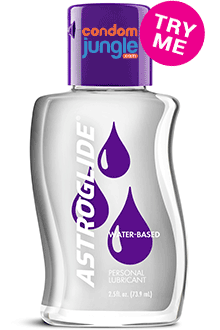
Astroglide Gel
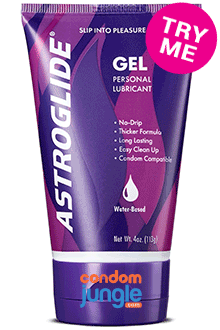
KY Jelly
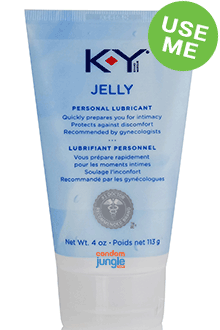
KY Liquid
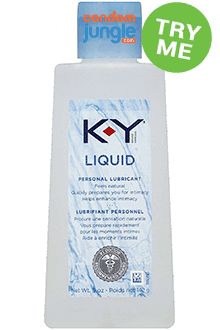
Silicone-based
Silicone-based lubricants don't contain any water, and their feel is different from their water-based counterparts. They also last much longer since they don't absorb in the skin. The condom manufacturing process widely uses silicone lubes for pre-lubrication before sealing a prophylactic into its wrapper.
Disadvantages of silicone-based lubricants
- not suitable to use with silicone sex toys
- some are not agreeable with condoms
Note: Not all silicone-based lubricants are compatible with latex condoms. Always look for any manufacturer's warnings printed on the retail box. Most likely if you don’t see messaging on the product label, you should be good to go with the condom.
Examples of silicone-based lubricants
Astroglide X
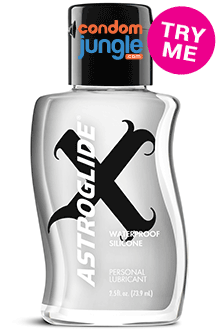
KY True Feel
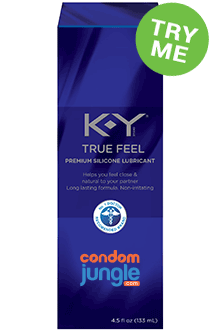
Oil-based lubricants
Oil-based lubricants tend to weaken latex, which makes them a poor match for condoms of that type. Why is this so bad? Weakening the material may cause to loss its elasticity and that makes condoms more prone to breakage and slippage.
Whatever you are using: essential oils, coconut oil or any other oil-based variations as a personal lubricant, always read the label to look for a reference to use for intimate activities.
Warning: We advise not using oil-based lubes with condoms. Any condoms! We doubt they are great for your privates either, but you can talk to you talk about that.
We carry almost no oil-based lubes because of their incompatibility with condoms. We feel that’s appropriate since we specialize in condoms and want to offer our customers what pairs best with prophylactics.
Astroglide O Massage Oil
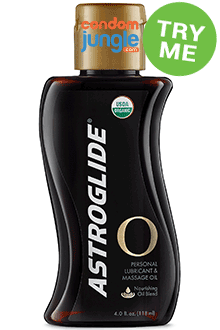
Specialty lubes
Another group of lubricants is those that add additional sensations for the user. A great example is warming lubricants.
KY Warming Jelly
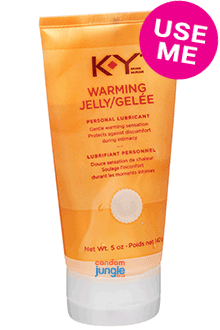
Astroglide Warming
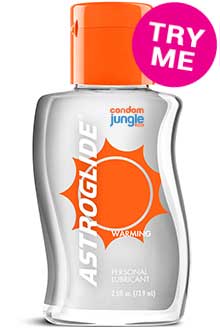
Medical use
Personal lubricants have medical uses as well. They ease discomfort during surgical procedures and examinations such as vaginal or anal ultrasounds. These lubes have bacteriostatic agents for keeping these types of substances sterile.
Kind of sexual activity
As we already mentioned there is no one-fits-all lube, and so some are better for this and other types are better for that. The good news is you should be able to find your match from what is available on the market.
- Vaginal
- Anal
- Masturbation
Vaginal
We already touched on the reasons for using lubricant to reduce vaginal dryness, which results in discomfort during sex.
Keep in mind that some lubes, including saliva, can potentially hurt sperm function. If you want to hump to conceive, consult with your doctor to make the right choices to keep the vagina healthy.
Anal
You can use a variety of lubricants safely for backdoor extracurricular activities. These thicker and richer lubes tend to work better than liquid varieties, which are much lighter. It all makes sense since you want the substance to stay in place and the gel (jelly) form does just that.
Masturbation
Whether you are up for a self-pleasuring session using a sex toy or only your fingers, personal lubricants help you as needed. You will be surprised as to how little you actually need to get things going.
Note: Keep in mind that silicone lubes are not compatible with silicone sex toys and vibrators. Instead, use water-based lubes.
Sex in the water
There are many places to have sex. We won't go down the list in this article. Since the possibilities are endless, we’re saving that for a future read. What we will mention is the type of lubricant that is an excellent match for sex in the shower or another wet place rendezvous. Deploy lubes with a silicone base for your underwater fornication missions.
Note: Watch your step when incorporating lube when playing around. Silicone can be extremely slippery especially on the tiled shower floor. You don't want to slip and slide your way to the emergency room instead of a beautiful, climaxing finish.
Packaging
There are typically three options for lubricant packaging.
- Bottle
- Tube
- Single-use packets
Bottles
Liquid lubes typically come in plastic bottles since they are the most suitable type of container for this quick spilling substance. Manufacturers usually offer several bottle sizes for a particular product -- anywhere between 2.5 to 5 ounces (oz) is perfect for personal use.
Tubes
All the thick and more rich gel (jelly) like lubes are available in plastic tubes. Just squeeze the desired amount on your fingers and apply to your private parts.
Note: Some brands use a pump instead of the classic bottle with an opening and closing cap. Some users find it more convenient since it can give you more control over the desired amount of lube.
Storing
As it is true with any perishable products you need to think of proper storage. You should avoid places where the temperature fluctuates in wide ranges. We recommend keeping it in your nightstand or closet at room temperature. Doing this helps keep the lube fresh and last as it was designed to. But, who are we kidding? We bet you use it in its entirety way before its shelf time is up.
Expiration date
Even personal lubricants, not just condoms, have a shelf life, which is located somewhere on the product itself. Depending on the manufacturer or brand the expiration date could be printed or pressed into the plastic surface. If it's printed chances are that it might rub off over time.
What are the best personal lubricants?
Everybody wants to know what's the best. That is a tricky question to answer since the market gives you many choices for lubes. It all boils down to your personal preference and how you are using the lube.
If you are entirely new to sex lubes we recommend trying both water and silicone options, in liquid and gel form, to see which you prefer. Based on that experience pick your faves for next time around.
Under the ideal circumstances and in a perfect world, the best lubricant would be no lubricant at all. How is that for a bold answer?
Let us explain. If our human bodies (women's vaginas to be specific) produced a ton of natural lubrication on their own when aroused, we wouldn't need any additional lubricants to apply. That makes sense, right?
Unfortunately, that is typically not the case for everybody though some women get moisturized when aroused more while others not so much. It is in no way a sign of being less or more aroused. It only means that your body system reacts differently to arousal impulses.
As we mentioned earlier, no matter how sexually aroused and excited women are, some vaginas don’t drip wet while others open the floodgates.
We briefly touched on the possible reasons for vaginal dryness earlier in this article. Most are all normal and a reflection of individual body inclinations. However, we can’t repeat enough, if you feel something isn’t right, consult with your medical professional.
Take away
Take it or leave it, life is better with choices, and personal lubricants give you a variety of wet options.
Whatever lube you end up using for your private activities make sure you get one that’s compatible with condoms.
Whichever way you do it and with whomever you do it with, get wet, be safe and Hump Responsibly.
